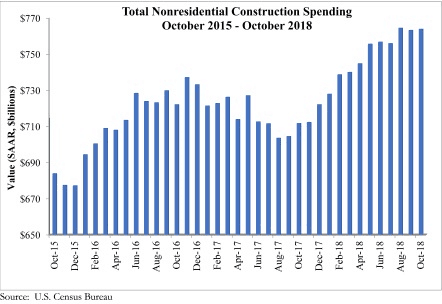
Nonresidential Spending Rises Modestly in October
National nonresidential spending increased 0.1 percent in October, according to an Associated Builders and Contractors analysis of U.S. Census Bureau data released today. Total nonresidential spending for the month stood at $763.8 billion on a seasonally adjusted annualized rate, which represents a 7.3 percent increase over the same time last year.

ABC Chief Economist Anirban Basu
Thirteen out of 16 subsectors are associated with year-over-year increases, with the exceptions being religious (-9.1 percent), communication (-4.7 percent), and health care (-1.0 percent). Water supply (+23.0 percent), lodging (+18.9 percent) and amusement and recreation (+16.2 percent) have generated the largest increases among nonresidential construction segments over the past 12 months.
“It is remarkable that the construction spending cycle remains firmly in place despite worker shortages, tariffs, rising materials prices, financial market volatility, more restrictive monetary policy, evidence of a slowing global economy and an abundance of political controversies,” said ABC Chief Economic Anirban Basu. “With backlog still elevated, nonresidential construction spending will enter 2019 with plentiful momentum.
“It is true that not all construction spending segments have participated in the industry’s recovery. However, the number of segments experiencing negative spending growth is small and the expectation is that a turnaround in spending is likely in at least two of these categories,” said Basu. “The religious category (-9.1 percent year-over-year) represents less than 1 percent of total nonresidential construction spending. Demographic forces and a strong economy should translate into growing demand for healthcare services, which will eventually trigger more construction in the health care category (-1.0 percent), including in the form of outpatient medical centers. The communication segment (-4.7 percent) includes data centers, which can be enormous. When construction of those facilities is complete, it can produce volatility or declines in spending. But given the exponential expansion in demand for data storage, communication stands to be a construction spending growth category going forward.
“While there will always be reasons to fret about the economic outlook, 2018 will go down as a fine year for the U.S. economy and for the nation’s nonresidential construction sector,” said Basu. “That said, while demand for construction services remained strong throughout the year, many contractors indicate that profit margins are under pressure. Given the ongoing dearth of available, skilled construction workers, that is likely to continue into 2019. However, materials price dynamics could be far different given a slowing global economy and expectations for a strong U.S. dollar next year.”






